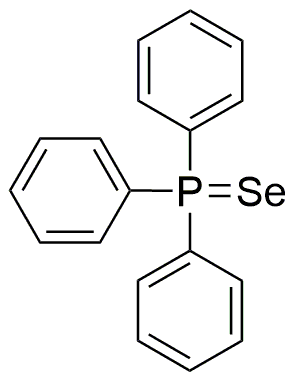Triphenylphosphine selenide is widely utilized in research focused on:
- Synthesis of Organoselenium Compounds: This compound serves as a key reagent in the synthesis of various organoselenium compounds, which are important in organic chemistry for developing pharmaceuticals and agrochemicals.
- Catalysis: It acts as a catalyst in organic reactions, particularly in the formation of carbon-selenium bonds, enhancing reaction efficiency and selectivity in the production of fine chemicals.
- Material Science: Used in the development of advanced materials, it contributes to the creation of conductive polymers and other materials with unique electronic properties, beneficial for electronics and energy applications.
- Biological Applications: The compound has shown potential in biological research, particularly in the study of selenium's role in biological systems, which can lead to the development of new therapeutic agents.
- Photovoltaics: Triphenylphosphine selenide is explored in the field of solar energy, where it can be used in the fabrication of photovoltaic cells, improving their efficiency and stability.
General Information
Properties
Safety and Regulations
Applications
Triphenylphosphine selenide is widely utilized in research focused on:
- Synthesis of Organoselenium Compounds: This compound serves as a key reagent in the synthesis of various organoselenium compounds, which are important in organic chemistry for developing pharmaceuticals and agrochemicals.
- Catalysis: It acts as a catalyst in organic reactions, particularly in the formation of carbon-selenium bonds, enhancing reaction efficiency and selectivity in the production of fine chemicals.
- Material Science: Used in the development of advanced materials, it contributes to the creation of conductive polymers and other materials with unique electronic properties, beneficial for electronics and energy applications.
- Biological Applications: The compound has shown potential in biological research, particularly in the study of selenium's role in biological systems, which can lead to the development of new therapeutic agents.
- Photovoltaics: Triphenylphosphine selenide is explored in the field of solar energy, where it can be used in the fabrication of photovoltaic cells, improving their efficiency and stability.
Documents
Safety Data Sheets (SDS)
The SDS provides comprehensive safety information on handling, storage, and disposal of the product.
Product Specification (PS)
The PS provides a comprehensive breakdown of the product’s properties, including chemical composition, physical state, purity, and storage requirements. It also details acceptable quality ranges and the product's intended applications.
Certificates of Analysis (COA)
Search for Certificates of Analysis (COA) by entering the products Lot Number. Lot and Batch Numbers can be found on a product’s label following the words ‘Lot’ or ‘Batch’.
Numéro de catalogue
Numéro de lot/série
Certificates Of Origin (COO)
This COO confirms the country where the product was manufactured, and also details the materials and components used in it and whether it is derived from natural, synthetic, or other specific sources. This certificate may be required for customs, trade, and regulatory compliance.
Numéro de catalogue
Numéro de lot/série
Safety Data Sheets (SDS)
The SDS provides comprehensive safety information on handling, storage, and disposal of the product.
DownloadProduct Specification (PS)
The PS provides a comprehensive breakdown of the product’s properties, including chemical composition, physical state, purity, and storage requirements. It also details acceptable quality ranges and the product's intended applications.
DownloadCertificates of Analysis (COA)
Search for Certificates of Analysis (COA) by entering the products Lot Number. Lot and Batch Numbers can be found on a product’s label following the words ‘Lot’ or ‘Batch’.
Numéro de catalogue
Numéro de lot/série
Certificates Of Origin (COO)
This COO confirms the country where the product was manufactured, and also details the materials and components used in it and whether it is derived from natural, synthetic, or other specific sources. This certificate may be required for customs, trade, and regulatory compliance.


